Accounting Standards Report: Case Studies on Australian Standards
VerifiedAdded on 2020/02/24
|9
|2381
|345
Report
AI Summary
This report provides a comprehensive analysis of accounting standards, focusing on practical application through case studies. The executive summary introduces the importance of accounting standards for companies and their alignment with government policies. The report delves into specific standards, including accounting policies, property, plant, and equipment, and provisions and contingent liabilities. The first case study examines Magenta Company's change in valuation method from cost to revaluation model, referencing AASB 108 and AASB 116 and providing journal entries. The second case study analyzes Greymouth Limited's chemical plant decommissioning, applying AASB 137 to determine the provision for decommissioning costs, including calculations and journal entries. The third case study evaluates the recognition of intangible assets, particularly computer software, based on AASB 138. The report concludes with recommendations for companies to correctly adopt and apply accounting standards, emphasizing their significance for stakeholders. The report uses Australian Accounting Standards as a reference and provides detailed calculations and journal entries for each case study. The report is designed to help students understand the practical aspects of accounting standards.
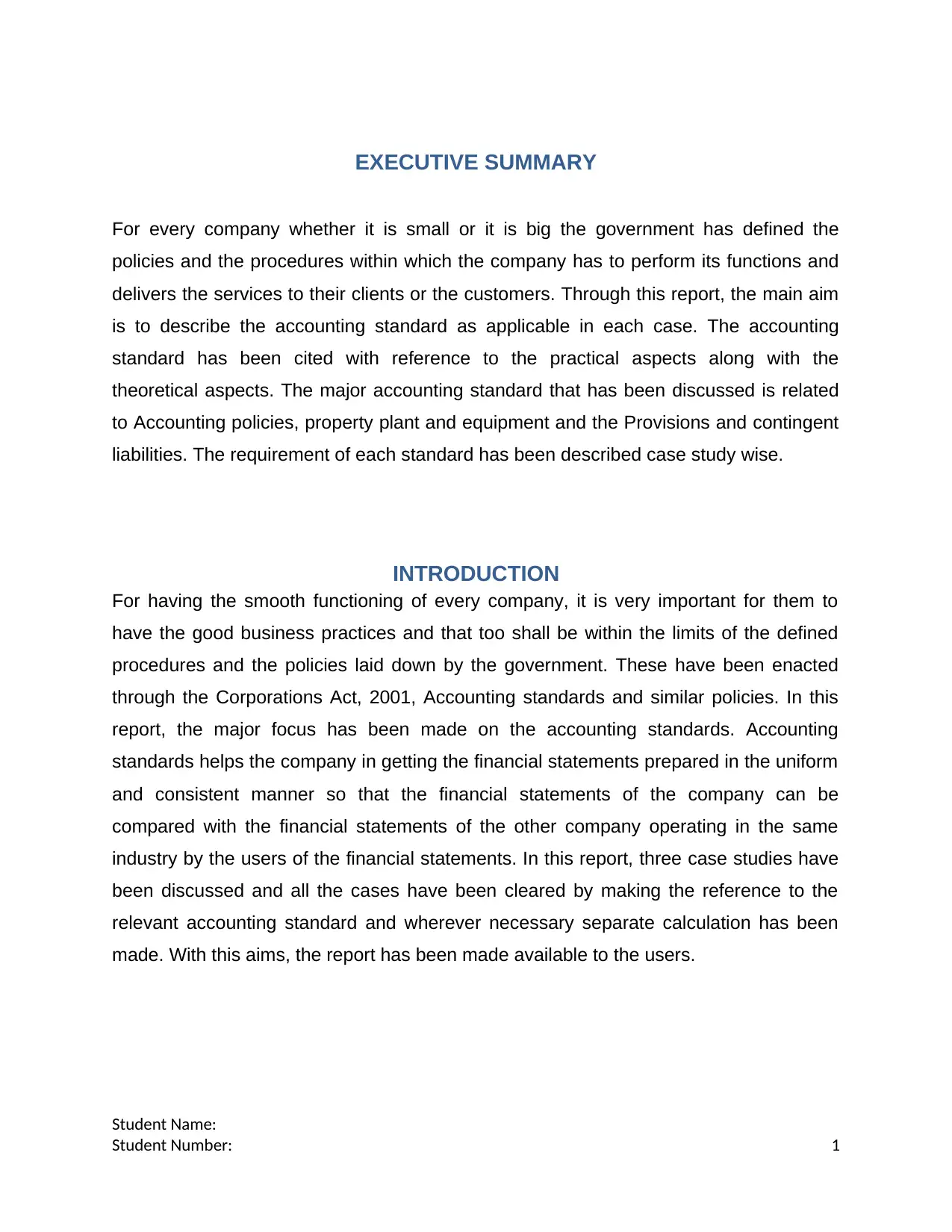
EXECUTIVE SUMMARY
For every company whether it is small or it is big the government has defined the
policies and the procedures within which the company has to perform its functions and
delivers the services to their clients or the customers. Through this report, the main aim
is to describe the accounting standard as applicable in each case. The accounting
standard has been cited with reference to the practical aspects along with the
theoretical aspects. The major accounting standard that has been discussed is related
to Accounting policies, property plant and equipment and the Provisions and contingent
liabilities. The requirement of each standard has been described case study wise.
INTRODUCTION
For having the smooth functioning of every company, it is very important for them to
have the good business practices and that too shall be within the limits of the defined
procedures and the policies laid down by the government. These have been enacted
through the Corporations Act, 2001, Accounting standards and similar policies. In this
report, the major focus has been made on the accounting standards. Accounting
standards helps the company in getting the financial statements prepared in the uniform
and consistent manner so that the financial statements of the company can be
compared with the financial statements of the other company operating in the same
industry by the users of the financial statements. In this report, three case studies have
been discussed and all the cases have been cleared by making the reference to the
relevant accounting standard and wherever necessary separate calculation has been
made. With this aims, the report has been made available to the users.
Student Name:
Student Number: 1
For every company whether it is small or it is big the government has defined the
policies and the procedures within which the company has to perform its functions and
delivers the services to their clients or the customers. Through this report, the main aim
is to describe the accounting standard as applicable in each case. The accounting
standard has been cited with reference to the practical aspects along with the
theoretical aspects. The major accounting standard that has been discussed is related
to Accounting policies, property plant and equipment and the Provisions and contingent
liabilities. The requirement of each standard has been described case study wise.
INTRODUCTION
For having the smooth functioning of every company, it is very important for them to
have the good business practices and that too shall be within the limits of the defined
procedures and the policies laid down by the government. These have been enacted
through the Corporations Act, 2001, Accounting standards and similar policies. In this
report, the major focus has been made on the accounting standards. Accounting
standards helps the company in getting the financial statements prepared in the uniform
and consistent manner so that the financial statements of the company can be
compared with the financial statements of the other company operating in the same
industry by the users of the financial statements. In this report, three case studies have
been discussed and all the cases have been cleared by making the reference to the
relevant accounting standard and wherever necessary separate calculation has been
made. With this aims, the report has been made available to the users.
Student Name:
Student Number: 1
Paraphrase This Document
Need a fresh take? Get an instant paraphrase of this document with our AI Paraphraser
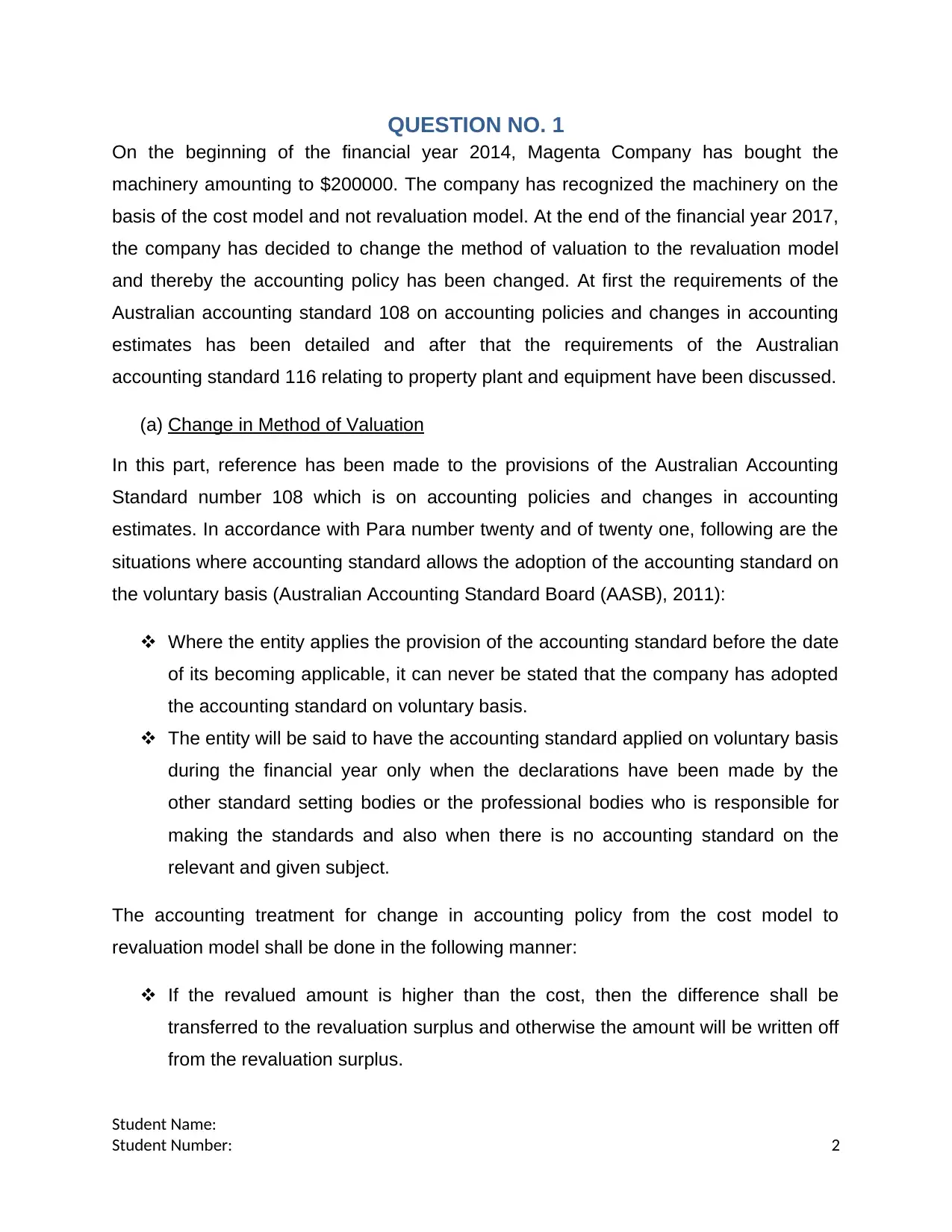
QUESTION NO. 1
On the beginning of the financial year 2014, Magenta Company has bought the
machinery amounting to $200000. The company has recognized the machinery on the
basis of the cost model and not revaluation model. At the end of the financial year 2017,
the company has decided to change the method of valuation to the revaluation model
and thereby the accounting policy has been changed. At first the requirements of the
Australian accounting standard 108 on accounting policies and changes in accounting
estimates has been detailed and after that the requirements of the Australian
accounting standard 116 relating to property plant and equipment have been discussed.
(a) Change in Method of Valuation
In this part, reference has been made to the provisions of the Australian Accounting
Standard number 108 which is on accounting policies and changes in accounting
estimates. In accordance with Para number twenty and of twenty one, following are the
situations where accounting standard allows the adoption of the accounting standard on
the voluntary basis (Australian Accounting Standard Board (AASB), 2011):
Where the entity applies the provision of the accounting standard before the date
of its becoming applicable, it can never be stated that the company has adopted
the accounting standard on voluntary basis.
The entity will be said to have the accounting standard applied on voluntary basis
during the financial year only when the declarations have been made by the
other standard setting bodies or the professional bodies who is responsible for
making the standards and also when there is no accounting standard on the
relevant and given subject.
The accounting treatment for change in accounting policy from the cost model to
revaluation model shall be done in the following manner:
If the revalued amount is higher than the cost, then the difference shall be
transferred to the revaluation surplus and otherwise the amount will be written off
from the revaluation surplus.
Student Name:
Student Number: 2
On the beginning of the financial year 2014, Magenta Company has bought the
machinery amounting to $200000. The company has recognized the machinery on the
basis of the cost model and not revaluation model. At the end of the financial year 2017,
the company has decided to change the method of valuation to the revaluation model
and thereby the accounting policy has been changed. At first the requirements of the
Australian accounting standard 108 on accounting policies and changes in accounting
estimates has been detailed and after that the requirements of the Australian
accounting standard 116 relating to property plant and equipment have been discussed.
(a) Change in Method of Valuation
In this part, reference has been made to the provisions of the Australian Accounting
Standard number 108 which is on accounting policies and changes in accounting
estimates. In accordance with Para number twenty and of twenty one, following are the
situations where accounting standard allows the adoption of the accounting standard on
the voluntary basis (Australian Accounting Standard Board (AASB), 2011):
Where the entity applies the provision of the accounting standard before the date
of its becoming applicable, it can never be stated that the company has adopted
the accounting standard on voluntary basis.
The entity will be said to have the accounting standard applied on voluntary basis
during the financial year only when the declarations have been made by the
other standard setting bodies or the professional bodies who is responsible for
making the standards and also when there is no accounting standard on the
relevant and given subject.
The accounting treatment for change in accounting policy from the cost model to
revaluation model shall be done in the following manner:
If the revalued amount is higher than the cost, then the difference shall be
transferred to the revaluation surplus and otherwise the amount will be written off
from the revaluation surplus.
Student Name:
Student Number: 2
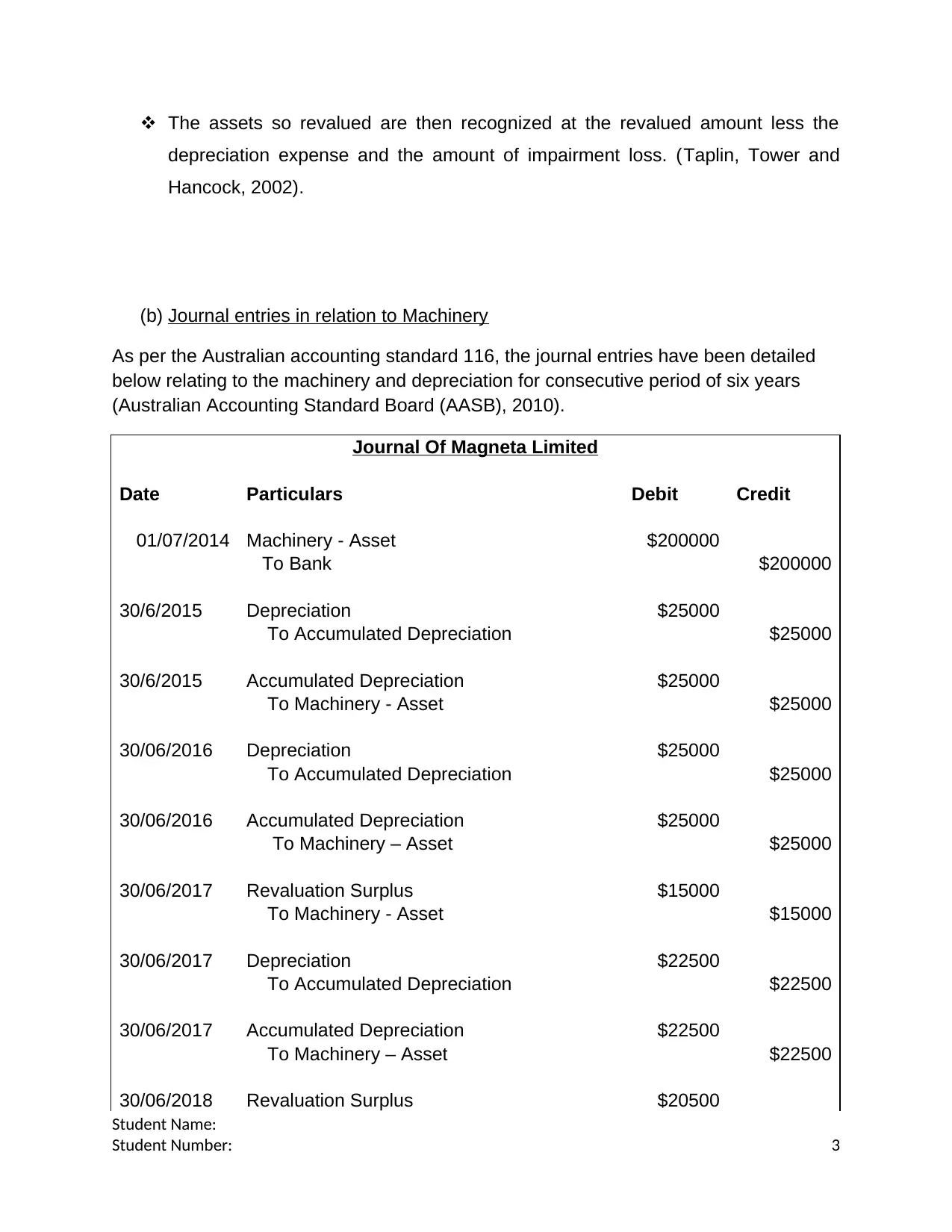
The assets so revalued are then recognized at the revalued amount less the
depreciation expense and the amount of impairment loss. (Taplin, Tower and
Hancock, 2002).
(b) Journal entries in relation to Machinery
As per the Australian accounting standard 116, the journal entries have been detailed
below relating to the machinery and depreciation for consecutive period of six years
(Australian Accounting Standard Board (AASB), 2010).
Journal Of Magneta Limited
Date Particulars Debit Credit
01/07/2014 Machinery - Asset $200000
To Bank $200000
30/6/2015 Depreciation $25000
To Accumulated Depreciation $25000
30/6/2015 Accumulated Depreciation $25000
To Machinery - Asset $25000
30/06/2016 Depreciation $25000
To Accumulated Depreciation $25000
30/06/2016 Accumulated Depreciation $25000
To Machinery – Asset $25000
30/06/2017 Revaluation Surplus $15000
To Machinery - Asset $15000
30/06/2017 Depreciation $22500
To Accumulated Depreciation $22500
30/06/2017 Accumulated Depreciation $22500
To Machinery – Asset $22500
30/06/2018 Revaluation Surplus $20500
Student Name:
Student Number: 3
depreciation expense and the amount of impairment loss. (Taplin, Tower and
Hancock, 2002).
(b) Journal entries in relation to Machinery
As per the Australian accounting standard 116, the journal entries have been detailed
below relating to the machinery and depreciation for consecutive period of six years
(Australian Accounting Standard Board (AASB), 2010).
Journal Of Magneta Limited
Date Particulars Debit Credit
01/07/2014 Machinery - Asset $200000
To Bank $200000
30/6/2015 Depreciation $25000
To Accumulated Depreciation $25000
30/6/2015 Accumulated Depreciation $25000
To Machinery - Asset $25000
30/06/2016 Depreciation $25000
To Accumulated Depreciation $25000
30/06/2016 Accumulated Depreciation $25000
To Machinery – Asset $25000
30/06/2017 Revaluation Surplus $15000
To Machinery - Asset $15000
30/06/2017 Depreciation $22500
To Accumulated Depreciation $22500
30/06/2017 Accumulated Depreciation $22500
To Machinery – Asset $22500
30/06/2018 Revaluation Surplus $20500
Student Name:
Student Number: 3
⊘ This is a preview!⊘
Do you want full access?
Subscribe today to unlock all pages.

Trusted by 1+ million students worldwide
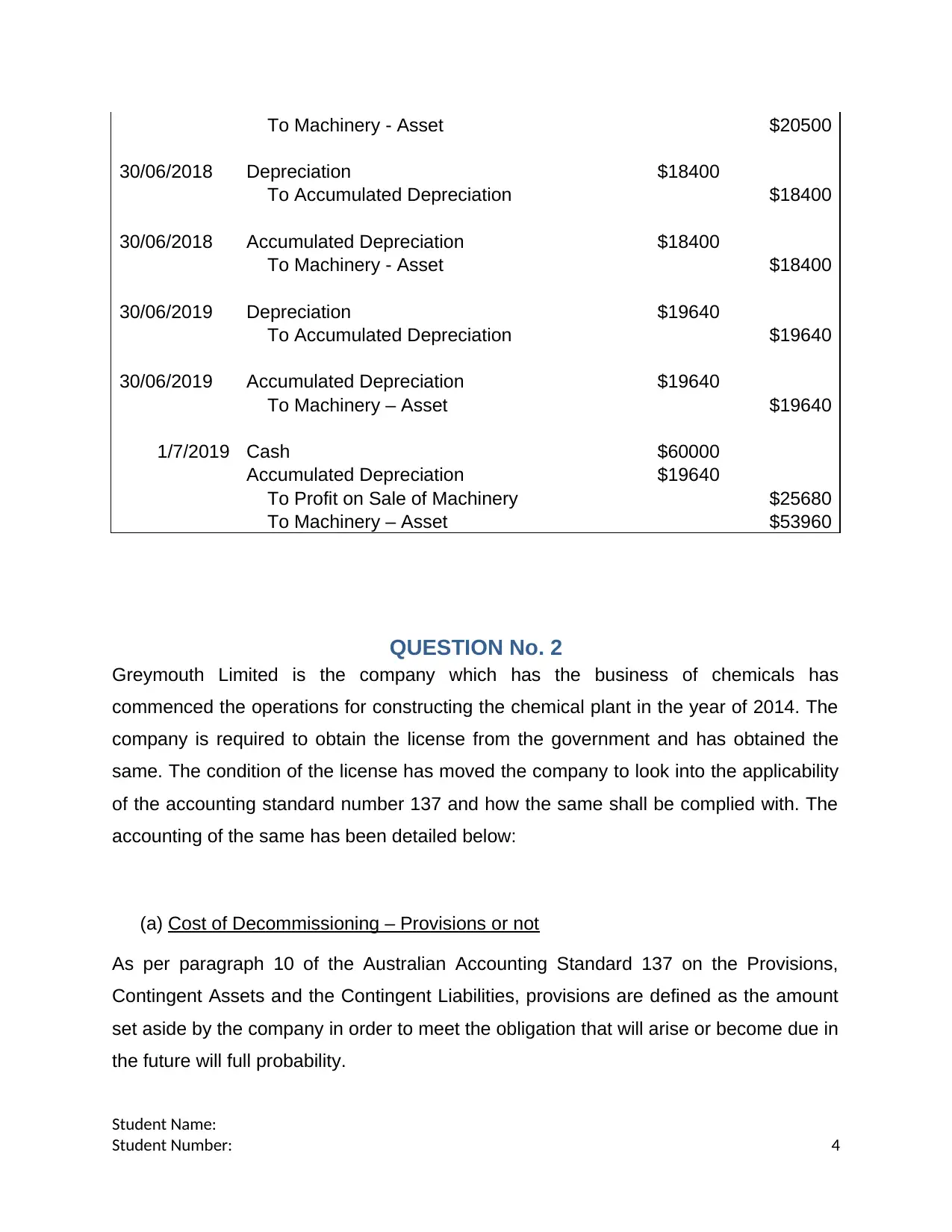
To Machinery - Asset $20500
30/06/2018 Depreciation $18400
To Accumulated Depreciation $18400
30/06/2018 Accumulated Depreciation $18400
To Machinery - Asset $18400
30/06/2019 Depreciation $19640
To Accumulated Depreciation $19640
30/06/2019 Accumulated Depreciation $19640
To Machinery – Asset $19640
1/7/2019 Cash $60000
Accumulated Depreciation $19640
To Profit on Sale of Machinery $25680
To Machinery – Asset $53960
QUESTION No. 2
Greymouth Limited is the company which has the business of chemicals has
commenced the operations for constructing the chemical plant in the year of 2014. The
company is required to obtain the license from the government and has obtained the
same. The condition of the license has moved the company to look into the applicability
of the accounting standard number 137 and how the same shall be complied with. The
accounting of the same has been detailed below:
(a) Cost of Decommissioning – Provisions or not
As per paragraph 10 of the Australian Accounting Standard 137 on the Provisions,
Contingent Assets and the Contingent Liabilities, provisions are defined as the amount
set aside by the company in order to meet the obligation that will arise or become due in
the future will full probability.
Student Name:
Student Number: 4
30/06/2018 Depreciation $18400
To Accumulated Depreciation $18400
30/06/2018 Accumulated Depreciation $18400
To Machinery - Asset $18400
30/06/2019 Depreciation $19640
To Accumulated Depreciation $19640
30/06/2019 Accumulated Depreciation $19640
To Machinery – Asset $19640
1/7/2019 Cash $60000
Accumulated Depreciation $19640
To Profit on Sale of Machinery $25680
To Machinery – Asset $53960
QUESTION No. 2
Greymouth Limited is the company which has the business of chemicals has
commenced the operations for constructing the chemical plant in the year of 2014. The
company is required to obtain the license from the government and has obtained the
same. The condition of the license has moved the company to look into the applicability
of the accounting standard number 137 and how the same shall be complied with. The
accounting of the same has been detailed below:
(a) Cost of Decommissioning – Provisions or not
As per paragraph 10 of the Australian Accounting Standard 137 on the Provisions,
Contingent Assets and the Contingent Liabilities, provisions are defined as the amount
set aside by the company in order to meet the obligation that will arise or become due in
the future will full probability.
Student Name:
Student Number: 4
Paraphrase This Document
Need a fresh take? Get an instant paraphrase of this document with our AI Paraphraser
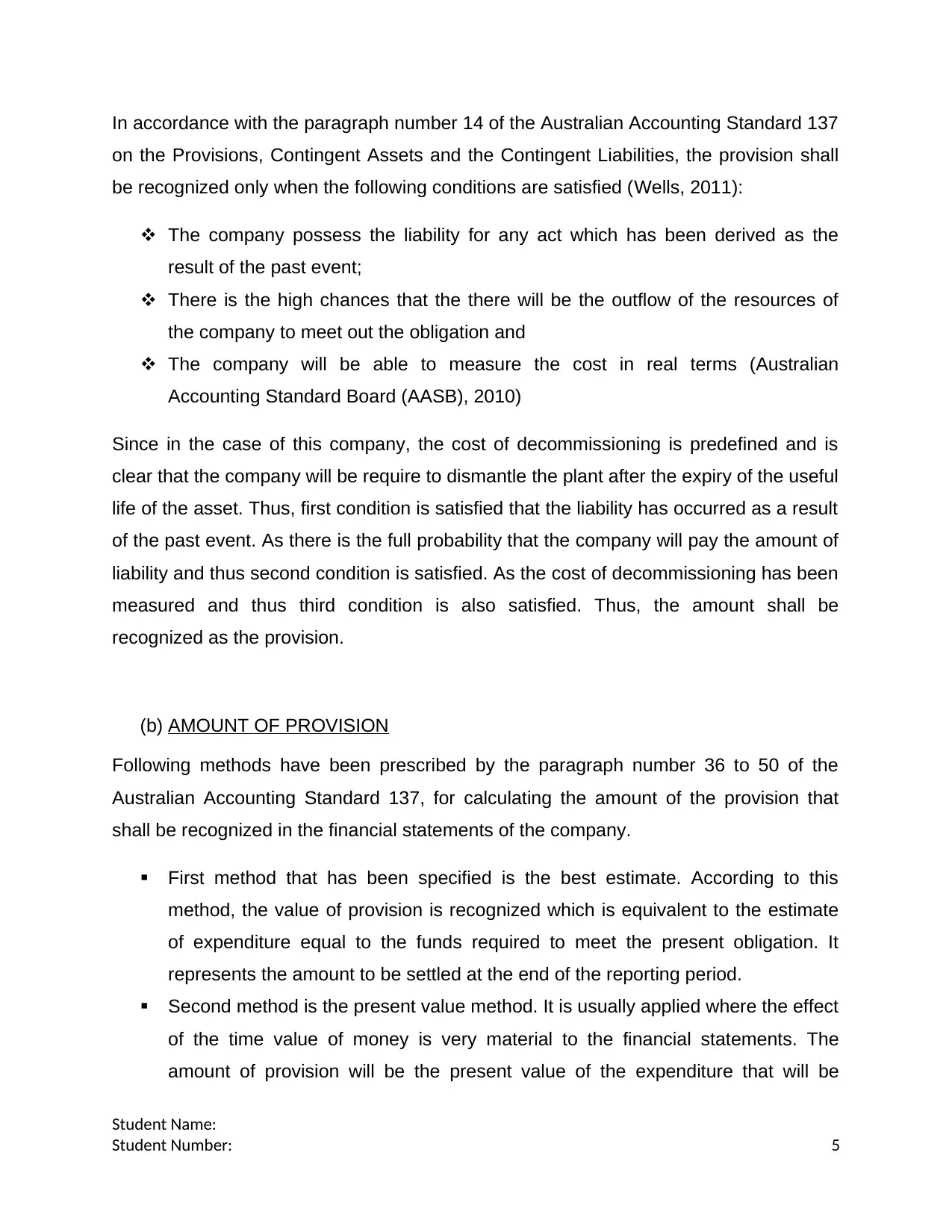
In accordance with the paragraph number 14 of the Australian Accounting Standard 137
on the Provisions, Contingent Assets and the Contingent Liabilities, the provision shall
be recognized only when the following conditions are satisfied (Wells, 2011):
The company possess the liability for any act which has been derived as the
result of the past event;
There is the high chances that the there will be the outflow of the resources of
the company to meet out the obligation and
The company will be able to measure the cost in real terms (Australian
Accounting Standard Board (AASB), 2010)
Since in the case of this company, the cost of decommissioning is predefined and is
clear that the company will be require to dismantle the plant after the expiry of the useful
life of the asset. Thus, first condition is satisfied that the liability has occurred as a result
of the past event. As there is the full probability that the company will pay the amount of
liability and thus second condition is satisfied. As the cost of decommissioning has been
measured and thus third condition is also satisfied. Thus, the amount shall be
recognized as the provision.
(b) AMOUNT OF PROVISION
Following methods have been prescribed by the paragraph number 36 to 50 of the
Australian Accounting Standard 137, for calculating the amount of the provision that
shall be recognized in the financial statements of the company.
First method that has been specified is the best estimate. According to this
method, the value of provision is recognized which is equivalent to the estimate
of expenditure equal to the funds required to meet the present obligation. It
represents the amount to be settled at the end of the reporting period.
Second method is the present value method. It is usually applied where the effect
of the time value of money is very material to the financial statements. The
amount of provision will be the present value of the expenditure that will be
Student Name:
Student Number: 5
on the Provisions, Contingent Assets and the Contingent Liabilities, the provision shall
be recognized only when the following conditions are satisfied (Wells, 2011):
The company possess the liability for any act which has been derived as the
result of the past event;
There is the high chances that the there will be the outflow of the resources of
the company to meet out the obligation and
The company will be able to measure the cost in real terms (Australian
Accounting Standard Board (AASB), 2010)
Since in the case of this company, the cost of decommissioning is predefined and is
clear that the company will be require to dismantle the plant after the expiry of the useful
life of the asset. Thus, first condition is satisfied that the liability has occurred as a result
of the past event. As there is the full probability that the company will pay the amount of
liability and thus second condition is satisfied. As the cost of decommissioning has been
measured and thus third condition is also satisfied. Thus, the amount shall be
recognized as the provision.
(b) AMOUNT OF PROVISION
Following methods have been prescribed by the paragraph number 36 to 50 of the
Australian Accounting Standard 137, for calculating the amount of the provision that
shall be recognized in the financial statements of the company.
First method that has been specified is the best estimate. According to this
method, the value of provision is recognized which is equivalent to the estimate
of expenditure equal to the funds required to meet the present obligation. It
represents the amount to be settled at the end of the reporting period.
Second method is the present value method. It is usually applied where the effect
of the time value of money is very material to the financial statements. The
amount of provision will be the present value of the expenditure that will be
Student Name:
Student Number: 5
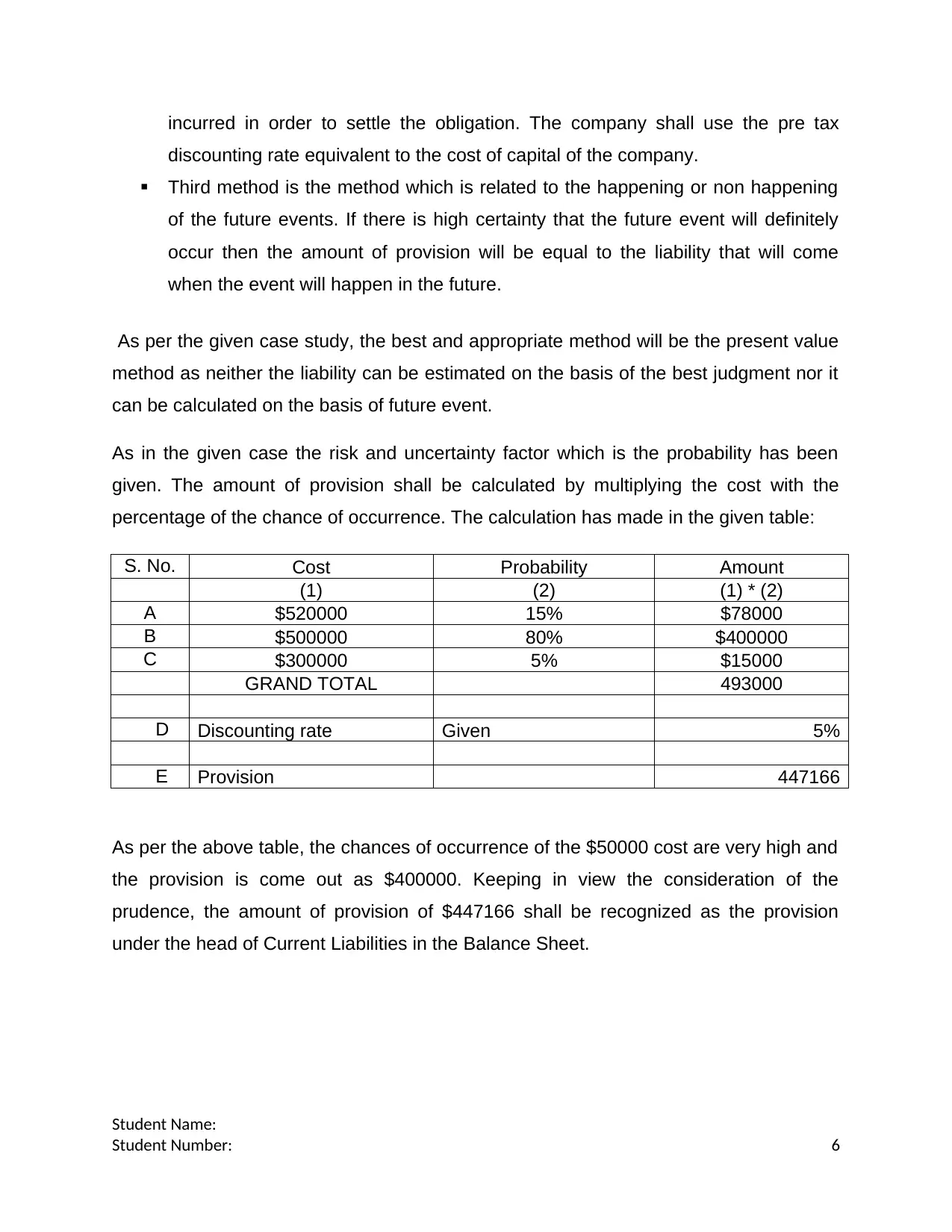
incurred in order to settle the obligation. The company shall use the pre tax
discounting rate equivalent to the cost of capital of the company.
Third method is the method which is related to the happening or non happening
of the future events. If there is high certainty that the future event will definitely
occur then the amount of provision will be equal to the liability that will come
when the event will happen in the future.
As per the given case study, the best and appropriate method will be the present value
method as neither the liability can be estimated on the basis of the best judgment nor it
can be calculated on the basis of future event.
As in the given case the risk and uncertainty factor which is the probability has been
given. The amount of provision shall be calculated by multiplying the cost with the
percentage of the chance of occurrence. The calculation has made in the given table:
S. No. Cost Probability Amount
(1) (2) (1) * (2)
A $520000 15% $78000
B $500000 80% $400000
C $300000 5% $15000
GRAND TOTAL 493000
D Discounting rate Given 5%
E Provision 447166
As per the above table, the chances of occurrence of the $50000 cost are very high and
the provision is come out as $400000. Keeping in view the consideration of the
prudence, the amount of provision of $447166 shall be recognized as the provision
under the head of Current Liabilities in the Balance Sheet.
Student Name:
Student Number: 6
discounting rate equivalent to the cost of capital of the company.
Third method is the method which is related to the happening or non happening
of the future events. If there is high certainty that the future event will definitely
occur then the amount of provision will be equal to the liability that will come
when the event will happen in the future.
As per the given case study, the best and appropriate method will be the present value
method as neither the liability can be estimated on the basis of the best judgment nor it
can be calculated on the basis of future event.
As in the given case the risk and uncertainty factor which is the probability has been
given. The amount of provision shall be calculated by multiplying the cost with the
percentage of the chance of occurrence. The calculation has made in the given table:
S. No. Cost Probability Amount
(1) (2) (1) * (2)
A $520000 15% $78000
B $500000 80% $400000
C $300000 5% $15000
GRAND TOTAL 493000
D Discounting rate Given 5%
E Provision 447166
As per the above table, the chances of occurrence of the $50000 cost are very high and
the provision is come out as $400000. Keeping in view the consideration of the
prudence, the amount of provision of $447166 shall be recognized as the provision
under the head of Current Liabilities in the Balance Sheet.
Student Name:
Student Number: 6
⊘ This is a preview!⊘
Do you want full access?
Subscribe today to unlock all pages.

Trusted by 1+ million students worldwide
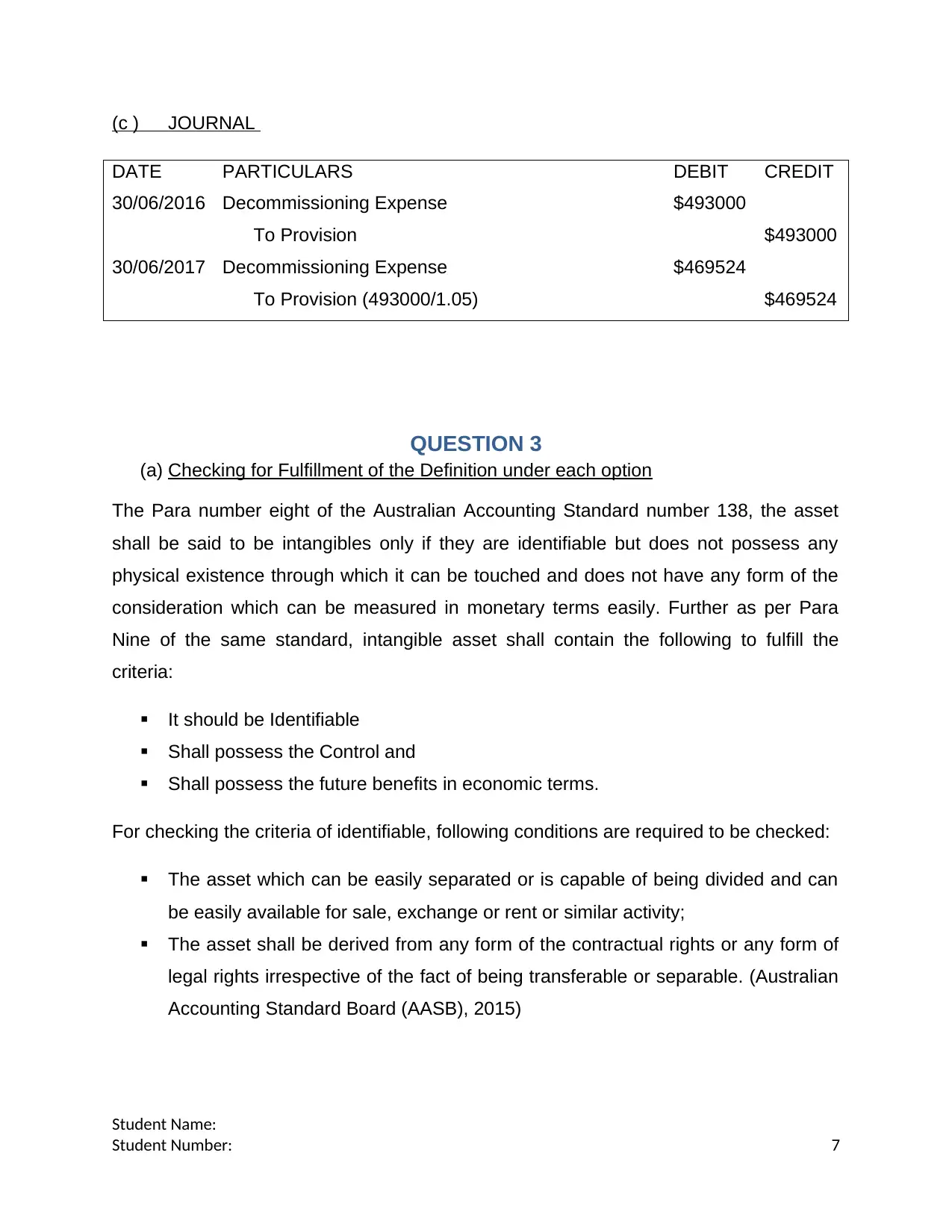
(c ) JOURNAL
DATE PARTICULARS DEBIT CREDIT
30/06/2016 Decommissioning Expense $493000
To Provision $493000
30/06/2017 Decommissioning Expense $469524
To Provision (493000/1.05) $469524
QUESTION 3
(a) Checking for Fulfillment of the Definition under each option
The Para number eight of the Australian Accounting Standard number 138, the asset
shall be said to be intangibles only if they are identifiable but does not possess any
physical existence through which it can be touched and does not have any form of the
consideration which can be measured in monetary terms easily. Further as per Para
Nine of the same standard, intangible asset shall contain the following to fulfill the
criteria:
It should be Identifiable
Shall possess the Control and
Shall possess the future benefits in economic terms.
For checking the criteria of identifiable, following conditions are required to be checked:
The asset which can be easily separated or is capable of being divided and can
be easily available for sale, exchange or rent or similar activity;
The asset shall be derived from any form of the contractual rights or any form of
legal rights irrespective of the fact of being transferable or separable. (Australian
Accounting Standard Board (AASB), 2015)
Student Name:
Student Number: 7
DATE PARTICULARS DEBIT CREDIT
30/06/2016 Decommissioning Expense $493000
To Provision $493000
30/06/2017 Decommissioning Expense $469524
To Provision (493000/1.05) $469524
QUESTION 3
(a) Checking for Fulfillment of the Definition under each option
The Para number eight of the Australian Accounting Standard number 138, the asset
shall be said to be intangibles only if they are identifiable but does not possess any
physical existence through which it can be touched and does not have any form of the
consideration which can be measured in monetary terms easily. Further as per Para
Nine of the same standard, intangible asset shall contain the following to fulfill the
criteria:
It should be Identifiable
Shall possess the Control and
Shall possess the future benefits in economic terms.
For checking the criteria of identifiable, following conditions are required to be checked:
The asset which can be easily separated or is capable of being divided and can
be easily available for sale, exchange or rent or similar activity;
The asset shall be derived from any form of the contractual rights or any form of
legal rights irrespective of the fact of being transferable or separable. (Australian
Accounting Standard Board (AASB), 2015)
Student Name:
Student Number: 7
Paraphrase This Document
Need a fresh take? Get an instant paraphrase of this document with our AI Paraphraser
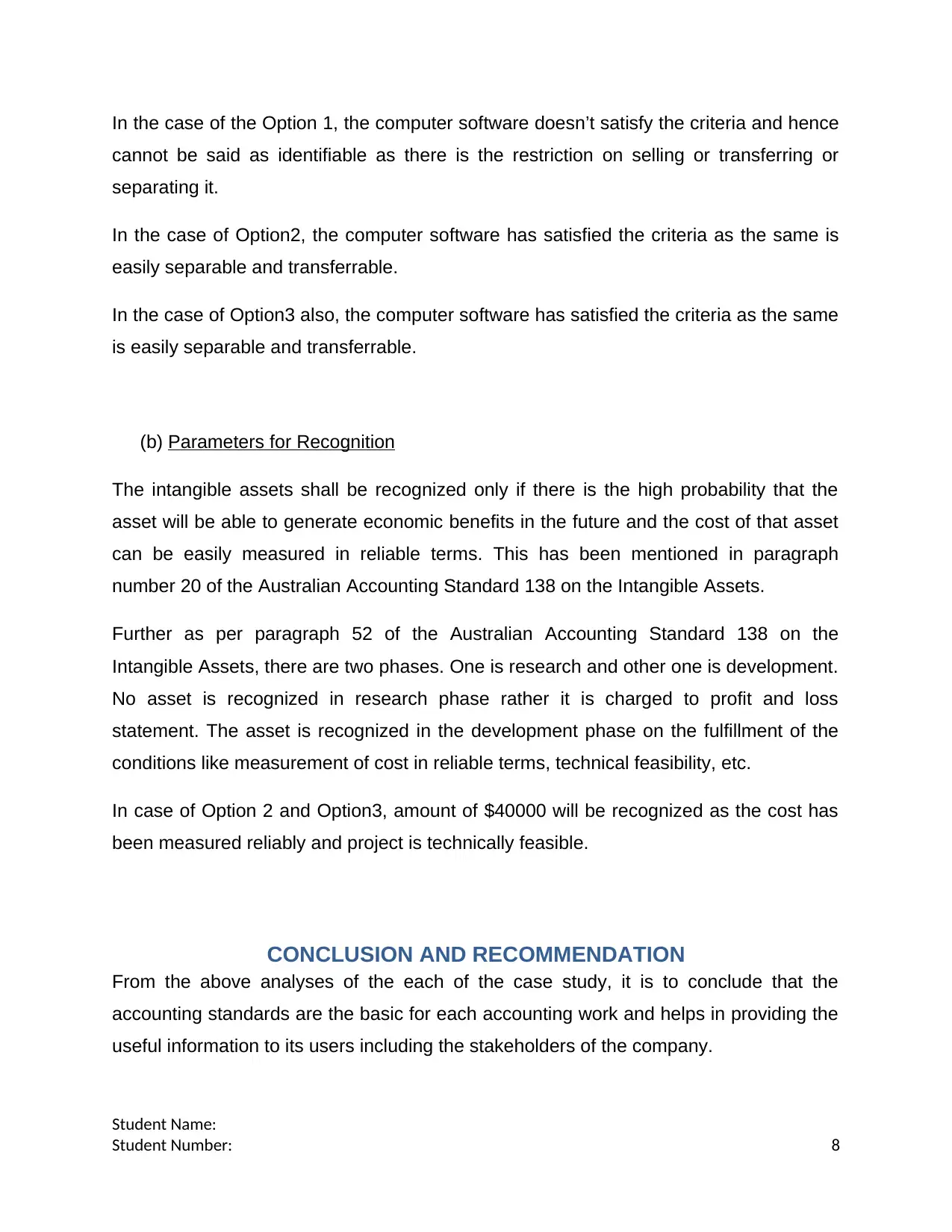
In the case of the Option 1, the computer software doesn’t satisfy the criteria and hence
cannot be said as identifiable as there is the restriction on selling or transferring or
separating it.
In the case of Option2, the computer software has satisfied the criteria as the same is
easily separable and transferrable.
In the case of Option3 also, the computer software has satisfied the criteria as the same
is easily separable and transferrable.
(b) Parameters for Recognition
The intangible assets shall be recognized only if there is the high probability that the
asset will be able to generate economic benefits in the future and the cost of that asset
can be easily measured in reliable terms. This has been mentioned in paragraph
number 20 of the Australian Accounting Standard 138 on the Intangible Assets.
Further as per paragraph 52 of the Australian Accounting Standard 138 on the
Intangible Assets, there are two phases. One is research and other one is development.
No asset is recognized in research phase rather it is charged to profit and loss
statement. The asset is recognized in the development phase on the fulfillment of the
conditions like measurement of cost in reliable terms, technical feasibility, etc.
In case of Option 2 and Option3, amount of $40000 will be recognized as the cost has
been measured reliably and project is technically feasible.
CONCLUSION AND RECOMMENDATION
From the above analyses of the each of the case study, it is to conclude that the
accounting standards are the basic for each accounting work and helps in providing the
useful information to its users including the stakeholders of the company.
Student Name:
Student Number: 8
cannot be said as identifiable as there is the restriction on selling or transferring or
separating it.
In the case of Option2, the computer software has satisfied the criteria as the same is
easily separable and transferrable.
In the case of Option3 also, the computer software has satisfied the criteria as the same
is easily separable and transferrable.
(b) Parameters for Recognition
The intangible assets shall be recognized only if there is the high probability that the
asset will be able to generate economic benefits in the future and the cost of that asset
can be easily measured in reliable terms. This has been mentioned in paragraph
number 20 of the Australian Accounting Standard 138 on the Intangible Assets.
Further as per paragraph 52 of the Australian Accounting Standard 138 on the
Intangible Assets, there are two phases. One is research and other one is development.
No asset is recognized in research phase rather it is charged to profit and loss
statement. The asset is recognized in the development phase on the fulfillment of the
conditions like measurement of cost in reliable terms, technical feasibility, etc.
In case of Option 2 and Option3, amount of $40000 will be recognized as the cost has
been measured reliably and project is technically feasible.
CONCLUSION AND RECOMMENDATION
From the above analyses of the each of the case study, it is to conclude that the
accounting standards are the basic for each accounting work and helps in providing the
useful information to its users including the stakeholders of the company.
Student Name:
Student Number: 8
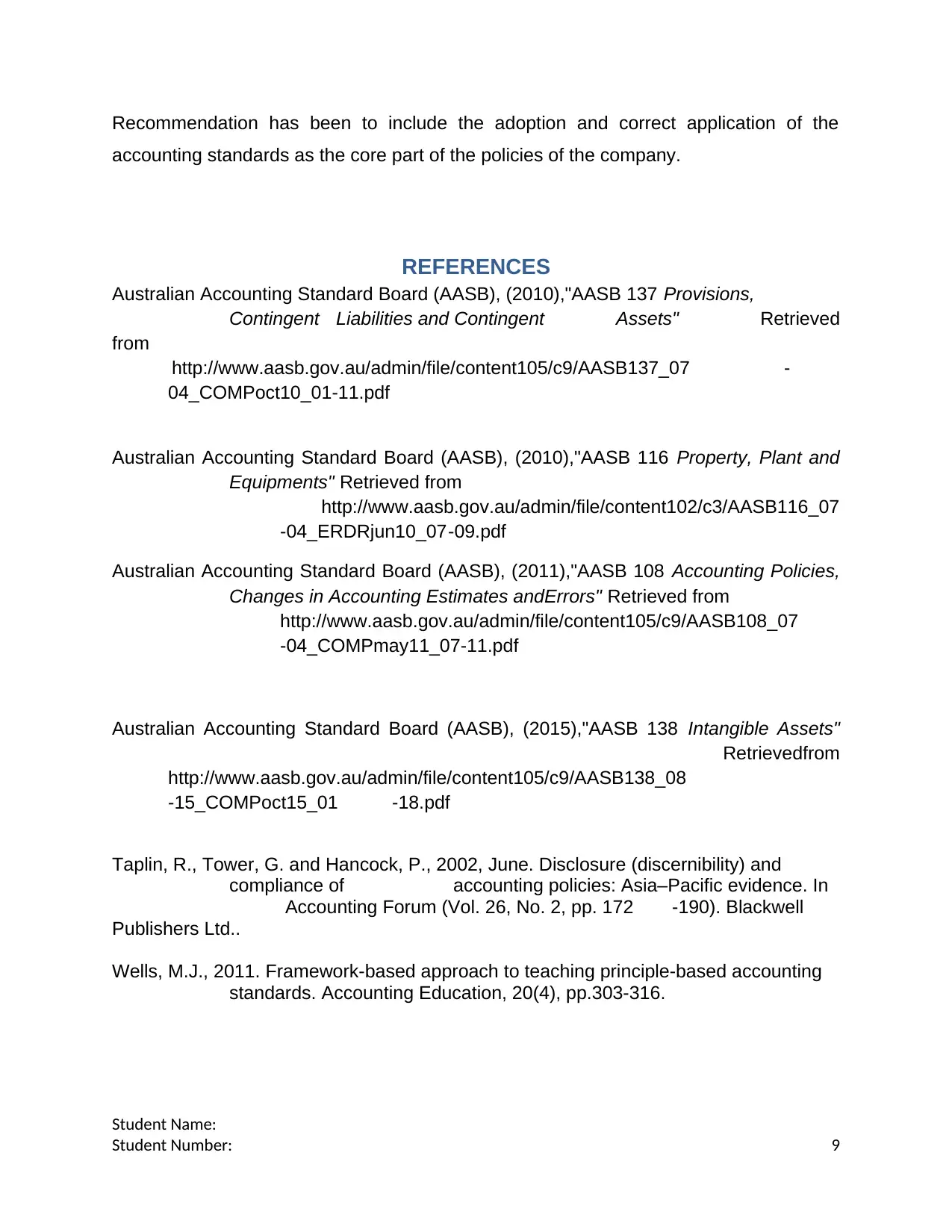
Recommendation has been to include the adoption and correct application of the
accounting standards as the core part of the policies of the company.
REFERENCES
Australian Accounting Standard Board (AASB), (2010),"AASB 137 Provisions,
Contingent Liabilities and Contingent Assets" Retrieved
from
http://www.aasb.gov.au/admin/file/content105/c9/AASB137_07 -
04_COMPoct10_01-11.pdf
Australian Accounting Standard Board (AASB), (2010),"AASB 116 Property, Plant and
Equipments" Retrieved from
http://www.aasb.gov.au/admin/file/content102/c3/AASB116_07
-04_ERDRjun10_07-09.pdf
Australian Accounting Standard Board (AASB), (2011),"AASB 108 Accounting Policies,
Changes in Accounting Estimates andErrors" Retrieved from
http://www.aasb.gov.au/admin/file/content105/c9/AASB108_07
-04_COMPmay11_07-11.pdf
Australian Accounting Standard Board (AASB), (2015),"AASB 138 Intangible Assets"
Retrievedfrom
http://www.aasb.gov.au/admin/file/content105/c9/AASB138_08
-15_COMPoct15_01 -18.pdf
Taplin, R., Tower, G. and Hancock, P., 2002, June. Disclosure (discernibility) and
compliance of accounting policies: Asia–Pacific evidence. In
Accounting Forum (Vol. 26, No. 2, pp. 172 -190). Blackwell
Publishers Ltd..
Wells, M.J., 2011. Framework-based approach to teaching principle-based accounting
standards. Accounting Education, 20(4), pp.303-316.
Student Name:
Student Number: 9
accounting standards as the core part of the policies of the company.
REFERENCES
Australian Accounting Standard Board (AASB), (2010),"AASB 137 Provisions,
Contingent Liabilities and Contingent Assets" Retrieved
from
http://www.aasb.gov.au/admin/file/content105/c9/AASB137_07 -
04_COMPoct10_01-11.pdf
Australian Accounting Standard Board (AASB), (2010),"AASB 116 Property, Plant and
Equipments" Retrieved from
http://www.aasb.gov.au/admin/file/content102/c3/AASB116_07
-04_ERDRjun10_07-09.pdf
Australian Accounting Standard Board (AASB), (2011),"AASB 108 Accounting Policies,
Changes in Accounting Estimates andErrors" Retrieved from
http://www.aasb.gov.au/admin/file/content105/c9/AASB108_07
-04_COMPmay11_07-11.pdf
Australian Accounting Standard Board (AASB), (2015),"AASB 138 Intangible Assets"
Retrievedfrom
http://www.aasb.gov.au/admin/file/content105/c9/AASB138_08
-15_COMPoct15_01 -18.pdf
Taplin, R., Tower, G. and Hancock, P., 2002, June. Disclosure (discernibility) and
compliance of accounting policies: Asia–Pacific evidence. In
Accounting Forum (Vol. 26, No. 2, pp. 172 -190). Blackwell
Publishers Ltd..
Wells, M.J., 2011. Framework-based approach to teaching principle-based accounting
standards. Accounting Education, 20(4), pp.303-316.
Student Name:
Student Number: 9
⊘ This is a preview!⊘
Do you want full access?
Subscribe today to unlock all pages.

Trusted by 1+ million students worldwide
1 out of 9
Related Documents
Your All-in-One AI-Powered Toolkit for Academic Success.
+13062052269
info@desklib.com
Available 24*7 on WhatsApp / Email
![[object Object]](/_next/static/media/star-bottom.7253800d.svg)
Unlock your academic potential
Copyright © 2020–2025 A2Z Services. All Rights Reserved. Developed and managed by ZUCOL.




